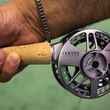Despite the vast array of hip/lumbar packs that have been on the market over the last handful of years, it is surprising how few actually end meeting expectations. Well, my expectations at least. And I've owned my share, from some of the best names in the business. Yet, even some of the packs I've owned from manufacturers that typically turn out well made, smartly functioning gear have fallen victim to many of the same pitfalls: inadequate construction quality, over-complicated design or poor wearability and/or on-the-stream usability (packs that seem great on the rack at the fly shop, but fail to deliver once they're on your hip and on the stream). So, when hip packs come along that do their job and do it well, they're worth talking about. Fishpond's Westwater Guide Lumbar pack is one of those.
What Works
Construction
The Westwater Guide Lumbar pack is part of Fishpond's Westwater collection of packs and bags, which all share the same aesthetics and design philosophy that revolves around the collection's heavy-duty construction, meant to take a beating and keep your gear dry. The construction of the Westwater collection is primarily 1680d TPU waterproof fabric, with water-resistant zippers securing all access points. It is important to note that the Guide Lumbar pack and the other bags in the Westwater collection are not waterproof, despite often being referred to as such. While the 1680d nylon the bags are almost wholly built out of is entirely waterproof, the zippers are not. The zippers are YKK #10 water-resistant zippers, not the YKK #5 Aquaseal or TZIP waterproof zippers found elsewhere. That said, you can expect a great deal of water resistance from these bags. I've fished in moderately heavy rain without concern, don't panic if the occasional dunking happens and my smartphone is inside and don't think twice about letting the bag get splashed, tossed down on boat floors and so on. It takes a bit of doing to get water into this bag, so it is going to keep things dry virtually all of the time, but please take care to understand these bags are not submersible.
Beyond offering near-waterproof water resistance, the 1680d construction offers up an impressive amount of hardiness. If you're someone who doesn't like to baby their equipment, as I am, then the Westwater Guide Lumbar pack's insult-proof construction is likely right up your alley. I've put the Guide Lumbar pack and its namesake in the collection, the Westwater Large Zippered Duffel through an unreasonable amount of abuse -- tossed down and dragged on shoreline rocks, stepped on with studded wading boots, scrambled over boulders and dragged through uncomfortably thick brush, stuffed into float plane cargo holds, and repeatedly sent mercilessly through commercial airline baggage handling -- for the last year or so, and they've soldiered through in virtually brand new condition. After a wipe (or hose) down, they look almost the same as the day they arrived. Zippers, pulls, straps, clasps and so on all have likewise emerged unscathed.

Functionality
Like most gear made these days that does its job and does it well, the Westwater Guide Lumbar pack does so through its simplicity. There's not too much going on here, and that's why it works. The pack features one front zippered pocket, lower-side cinch straps, a couple of D-rings and so on for attaching retractors, tippet holders and the like, and a main interior compartment that is quite neatly (and thankfully) divided into only 2 interior pockets, and that's about it.
What there is a lot of in the Guide Lumbar pack, is room. Offering a great deal of functional holding capacity -- it's not all about cubic inches, folks, that space has to be usable -- isn't notable in itself. Offering a great deal of storage area without being bulky, is. The pack offers a surprising amount of room (my large Montana Fly Company streamer/saltwater box that is more of a small suitcase than a fly box slides in with relative ease), but does so while weighing in at a paltry 1.4 pounds and sporting a profile that leaves you repeatedly surprised by what you're able to stuff into it.
Fit
I wear hip packs significantly more often than I wear sling packs, because I'm usually carting around a backpack stuffed with cameras and lenses, leaving me no place to sling a sling pack. Given that I'm wearing two bags, wearability and comfort is fairly important. This usually relegates me to sporting a very minimalist hip pack, as the Patagonia Stormfront backpack that typically holds my camera gear eats up the majority of my ample rear-side real estate. So, it was much to my delight discovering that the Westwater Guide Lumbar pack with its sturdy, near-waterproof construction and all of its roominess, manages to wear very minimally and eat up as little room as you could possibly expect it to, which allows me to wear it along with my backpack and do so relatively comfortably. There's a bit of juggling and jostling from time to time, but that's not much of a price to pay given that I'm asking two roomy, heavily constructed bags to play nicely together.
The Westwater Guide Lumbar pack rests very comfortably on the waist/hips, presumably thanks to the ample lumbar padding, and it swings around easily for access.
What Doesn't
It's hard to criticize Fishpond for not adding another feature to this pack in the midst of congratulating them for keeping things simple. Still, the one thing that often feels missing from the Westwater Guide Lumbar pack is a place tote a water bottle. There's no telling how this would affect wearability or comfort, so there may be a reason a water bottle compartment didn't make the cut.
If you prioritize water carrying over water resistance, there are other hip packs for you. Perhaps even another Fishpond offering in the Yampa Guide Pack we also just reviewed.
Final Word
It also bears mentioning that Fishpond's Westwater line, along with its new Cyclepond line, offers a more modern and updated aesthetic when compared to some of Fishpond's more traditional designs. As someone that wasn't crazy about look of the stuff that Fishpond was designing a few years back, this is a welcome change. Looks aren't everything, but they ain't nothing, either.
Fishpond has managed to offer a great deal of usability and durability in a surprisingly sleek and comfortably worn piece of gear. The Westwater Guide Lumbar pack doesn't try to do too much, instead it seems to endeavor to do a few things very well, and succeeds at doing so.































Comments
Tim replied on Permalink
I jumped on this pack in 2013 when I saw it. It was ~$130, but I was tired of my fly boxes getting wet in my other Fishpond waist pack. This happened if you wade deeply or knelt in the stream. The pack is definitely heavy duty. However, it did not end up working for me so I switched back to my other Fishpond waist pack. Here's why: #1 lack of partitions in this cavernous pack. It holds a lot of stuff, plenty actually, but not enough places to put all the gadgets I like to take with me. It felt like a free-for-all in there and finding things became a little frustrating. #2 Once you get water in the pack it stays there. It makes total sense to me, but again, a little problematic if you fish in the rain, spash some water in there, or the aforementioned water bottle leaks. This pack is a great step forward, but it's not quite there yet IMO.
Chad Shmukler replied on Permalink
Good thoughts, Tim. Shows how different features (or lack thereof) suit different folks. The minimalist compartmentalization was one of the features I liked best, but it is certainly easy to understand how someone that likes to tote more gear or organize differently might want more.
Brett replied on Permalink
Backbacks and vests spent too much time hung up in the trees and brush. I tried a wide variety of sling packs, and then worked my way through a host of waist packs and belts. Water bottles were almost always the sore spot--in the Midwest in summer, hiking in to streams in August heat can require serious water. Only the old Sage packs even allowed two water bottles, and if you carried them both, it slid down around your knees from the weight. Most packs did not allow swapping out pouches or accessories.
In the end, lack of modularity did them all in.
Finally pitched it all and bought a nice used Molle combat belt with lumbar support. After about $100 in trial and error with various attachments and pouches, found a nice arrangement. Can carry 32 ounces of water in a canteen, full emergency kit, four CF fly boxes, 7 spools tippet, a fold-out pouch to use as creel, two cameras, large pocket for misc gear (weight, floatant, etc), and everything else can be hooked in between those pouches directly to the belt on carabiners and loops. Scotch guarded the outside and it's water resistant. Even better, when I change locations I can change the set-up, and add a second canteen, a large fanny pack, waterproof GPS pouch, suspenders for added weight distribution, more fly box capacity, extra camera pouch for lenses, etc., with a few snaps.
If I were making it specifically for fishing, I would use a lighter fabric to cut the weight, but with all the weight at your waist you hardly notice it. Not ideal, but certainly beats anything the major vendors have come up with to date. Definitely wins when it comes to comfort for long hikes on hot days and mobility when scrambling up rocks or over fences. And modularity. And most definitely price.
Would be nice if vendors would take a look at what the military already figured out.
Chad Shmukler replied on Permalink
Brett --
Have you taken a look at Ethan Smith's stuff over at SmithFly? Pretty much all MOLLE based. Might be just what you're looking for.
Brett replied on Permalink
Nice, but to be honest, just plain ludicrously overpriced. I have the same pouch they call the 3x (at $60), and I paid probably $12 for a new one. Their $60 belt was a $23 purchase, also new (and it came with a full set of replacement connectors/buckles and straps). All appears to be same fabric as standard military gear as well. I am 100% in favor of someone getting this right (and re-engineering all of these packs in a lightweight, water resistant fabric), but not at the silly prices gear companies think they can charge. 300-500% markup because you slap a fly fishing picture on the packaging does not sit well with me.
But thanks for the pointer . . .
Ethan Smith replied on Permalink
Brett, I appreciate your concern about the SmithFly pricing structure and frankly I would LOVE to make SmithFly stuff more affordable and competitive with all the other MOLLE stuff out there but in reality when first starting out, like we are, we make things in small batches which drive the costs up significantly. Also, everything we make is Made in the USA, not cheap or easy. So sadly, we're not EVEN close to 300-500% markup. The price point has zero to do with slapping a fly fishing photo on it and everything to with the integrity with which we make things and by that I mean we aren't using cheap forced labor or dumping dye in our rivers at ANY step during the prodcution of our stuff. We have rules in this country. We follow the rules and that means sometimes thing are a little more expensive. On June 22 1969 the Cuyahoga River caught fire due to industrial pollution. We learned a lesson that day and later the clean water act was the direct result. We have been fighting for clean water ever since and as fly fishermen is something very important to all of us. China has yet to have that watershed moment with their pollution problem but I suspect it isn't far away. So yes it's cheaper to make things overseas. But I for one can sleep well at night knowing that I'm not contributing to China's horrible pollution problem through SmithFly in any way. The fact that our stuff is Made in the USA and is still in the same price ballpark with other big brands in the fly fishing world, who DO make things in China, is something I'm quite proud of and will never apologize for.
Pages